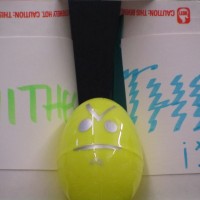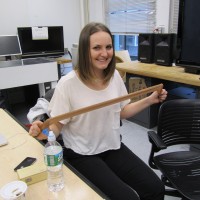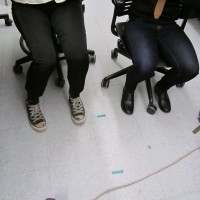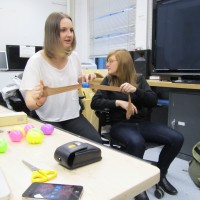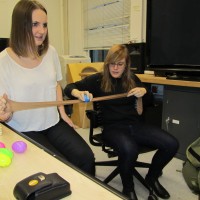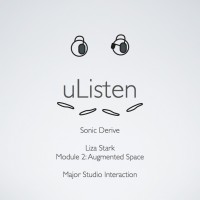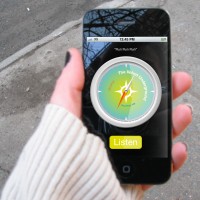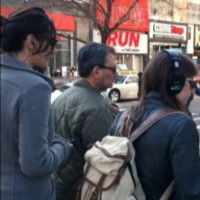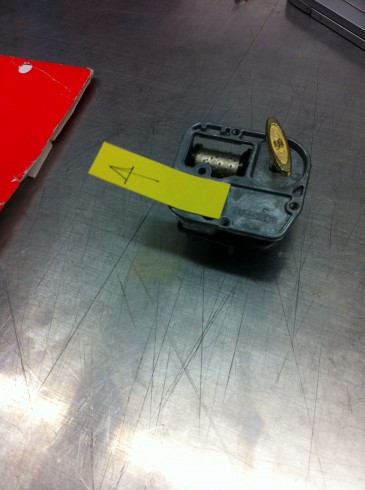Major Studio Final Project Concept
Tentative Title
Does Not Compute: An Investigation into Computational Points of Entry for Middle/High School Students
Concept
For my final project, I am going to compose a curriculum aimed at introducing middle to high school students to basic electronic, programming, and design concepts through soft circuits and a create a body of compiled and personal research surrounding this sphere.
Deliverables
As of right now I am still in the process of fully flushing this out, but I will include some or all of the following:
Big Ideas
This final project is the intersection of two recent conceptual preoccupations and a recent experience at a girl’s after school session at Quest to Learn. The first preoccupation centers directly on the mystification, or demystification, of technology. The second is the idea of a point of entry, specifically regarding technology.
Background
As for the third, I have recently been interning at Quest to Learn’s Short Circuit after school program. I usually go on Thursdays when the dominant population are 6th and 7th grade boys, along with one girl who I have been working with a variety of independent projects on. Over spring break, however, I had the chance to help plan and run the Girlz Jam (I have class at this time otherwise, much to my chagrin) in which a group of ten 7th grade girls come together for a 2 hour after school session centered around a weekly topic. I should mention that the goal of this program is specifically to encourage female after school participation by creating a shared creative space, especially since at this time in development, blurry elementary school gender lines begin to focus quite sharply.
While I have had experience running after school before, this session was quite unfocused and largely dictated by the girls with the organizers acting more like herders. First and foremost, I must say that after school is hard – students have just had a long day of school and really just want to listen to music and text their friends. Secondly, teaching soft circuits is extremely difficult: it requires a rewiring of your brain around both sewing and circuitry, not an easy feat especially for those who are novices to both. In spite of this, the potential was palatable enough for me to continue thinking about it for the past five days, and brought back previous work I had done in curriculum design and interaction design in spaces of learning. For me, the design problems that arise in these areas are fascinating. Combine that with the masochistic satisfaction of working with soft circuits and e-textiles, the intersection of these domains is endlessly stimulating.
The “WHY” and Audience
Based on countless studies and statistics, bodies of research, and simple observation or questioning, computation is a realm that most of the population feels estranged from, largely due to (as I will posit for a thesis) a psychological barrier resulting from lack of exposure or disinterest in the components that they traditionally associate with programming and physical computing.
It feels trite to state the following, but its significance cannot be underscored enough: students must have more exposure to and experience with working with various technologies. This is for a variety of reasons that we have all heard before – international competition, job preparation, etc – but for this project, I will assume these as established propositions and posit that engaging youth with this type of process is innovative in its inherent ability to unlock creative potential by challenging preconceptions of materials, processes, and the cultural milieu traditionally associated with them.
Further Concepts to Incorporate
I would like this project to have an open source focus. Open source movements are in full swing and are going to play a massive role in defining culture, economics, politics – life in general – in the coming years. Following from this, as technology has become more and more accessible, a significantly large portion of the public have undergone a transformation from consumer to producer. (I would like to note, however, that these roles are not binary and there is much grey space to be exploited in between.) By making youth more aware of the individual and collective benefits of open source and the communities surrounding it, they will be more likely to actively contribute, thereby both sharing knowledge and reinforcing their own.
Article: Why does the US fail in science education?
In thinking about the idea of creating an interactive book of psuedocode for mini-thesis, this article is hits upon one of the main reasons why science and math (re: coding) have such an inaccessible point of entry for most people:
“That notion — that you either have the gift or you don’t — “is particularly damaging in science because the reality of science is you’re basically always failing,” said Mr. Pellathy, who has a Ph.D. in physics.”
It mentions numerous other factors as well, but this is a key point that strikes people at a psychological level: if this is not overcome, further learning is easily disarmed. While my audience is not necessarily going to be K-12 or novice coders, this article hits the foundation of why most people have trepidation when approaching code in general.
Also, this will be the first of many articles I will post in an attempt to get all my research in one place. Here’s to it: http://www.post-gazette.com/pg/11079/1133328-84.stm
Feb. 15 Reading Responses
PLACE STORMING: PERFORMING NEW TECHNOLOGIES IN CONTEXT
Ken Anderson and Jane McGonigal
This paper stands in interesting contrast to the bodystorming reading. If body storming is for the user, place storming is more for the designer. I really like this concept of playful performance, and I especially enjoyed the shout out to Mikhail Bakhtin in discussing the process of discovery through play and its subversive qualities. These qualities become especially evident as tools used in place storming begin to be reappropriated as environments shift.
BODYSTORMING
Antti Oulasvirta, Esko Kurvinen, and Tomi Kankainen
As a methodology to better understand user needs and desires, I think bodystorming is a fantastic tool to get designers to think more in depth about the ways in which their desired interactions will actually play out among their users. From my own experience it has been invaluable, especially for the development of my Module 2 project. My initial ideas were a little muddied in terms of focus until I picked up my iPhone and pretended to follow other people. I adjusted the song volume as I went and also tested the distance at which I could remain behind someone without freaking them out too much. In the end it also formed my decision to center my project around the concept of the derive after finding that I actually wanted the experience to engage people in a way that engaged them in a nonauthoritarian way, but that also forced them to remain at the disposal of others to continue playing.
Module 3: Play
“Totally indulgent and want to keep shooting that shit.”
- Kellyn
Assignment
Take an existing game, analyze it, and identify its core mechanic. Then, extract that mechanic and design a new game around it.
Design Question
How can a physical game act as a serve to reduce goal-oriented anxiety and give players a sense of accomplishment and perspective over the stressful factors?
Overview
This game transports the catapult core mechanic of Angry Birds into a test of teamwork, physical coordination, and physics.
The goal is for teams of two to work together to knock over the stack of cups using a nylon catapult and plastic eggs in as short a time as possible from a distance of three feet. Knock them all over to graduate and make your angry nerds happy!
Concept
The concept and design is meant to give MFA DT students a fun way to alleviate shared stress associated with the program. By conquering major program milestones in a physical fashion, the game offers this audience immediate gratification and a sense of (control) over hurdles that can feel insurmountable at times.
In Action
How To Play
MATERIALS REQUIRED
RULES
1. Each team has two players.
2. Players divide into teams of two, then each team sets up their station: two chairs at least three feet away from the target; one nylon catapult; a stack of plastic eggs (nerds); three cups stacked in a pyramid (target goals)
3. Players must remain sitting in their chairs and cannot move closer to the target than the allotted space.
4. Players only have the stack of eggs given to them. They can keep shooting as much as they want, but they must retrieve their eggs and may not use another teams eggs!
5. The first team to knock over all three cups wins!
POSSIBLE CONFIGURATIONS
CLASS PLAYTEST
The feedback from the class was incredibly helpful and insightful. In further iterations I would begin with some type of color categorization of the egg “nerds” along with a weighting system to correspond to the color hierarchy. This would also be a starting point to integrate a points system. For as much as I love the idea of playing with pantyhose, I would of course rethink my materials, and I would also rethink the organization of cups. For example, it may lead to more interesting play if you had to shoot the egg in the cup. The narrative skin is also in need of further developing – while I like the concept of knocking out your goals, it is completely inapparent at the start and during game play.
Module 2: Place and Space
This project is a sonic derive that explores urban spaces by following the personal sonic spaces of others via iPods and other mobile music devices.
Assignment
Investigate the implications of digitally augmented hybrid environments though developing your own alteration or intervention in an existing space.
Design Question
How can we use the augmented space we create via our iPods to interact with our environment in a new way?
Overview
The excessive stimuli of urban spaces leaves little physical and mental space for the individuals that populate it. We have to find creative ways to carve personal space in public, but we can become easily disconnected with the people around us by the environments we create for ourselves
Concept
Based on the ideas of the Situationist derive, uListen allows seasoned urbanites a new way to meander through the city, away from their static routines and city noise in a playful way.Through this application, people can explore urban space by following the personal sonic spaces of others via iPods and other mobile music devices. Engaging in a game of unidirectional sound tag, players move through the city based on someone else’s path and routine.
In Action
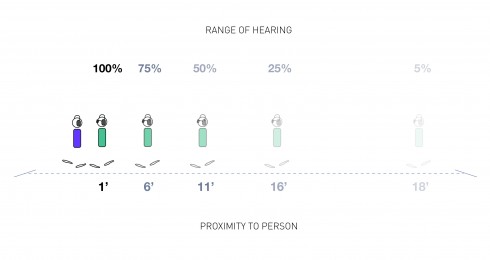
Documentation
Click here for full presentation.
Feb.10 Reading Responses
THE COMPUTER FOR THE 21ST CENTURY
Mark Weiser
This article is obviously way ahead of its time, very Vannevar Bushian for its insight into the evolution of technology’s integration into our lives. More interesting was his articulation and response to popular criticisms that would develop alongside the rise of ubiqutious computing, specifically the idea that more computer means less personal interaction. His distinction between virtual reality and ubiquitous computing caused the ground to tremble a bit beneath me, largely because I had never thought or been exposed to those two concepts as opposing. I instead grouped them together as most do as subsets of technology’s mediation on our lives. They definitely deserve distinction, more so for our psychological needs than anything else; a dialogue exploring the idea of enhancing vs. simulating reality needs to be addressed for a more general population.
He is very sober, practical, and successful in how he develops his argument favoring ubquitous computing. Weiser aligns it completely with the needs and desires of a particular business audience but also illustrates how from there it will continue to enhance other spheres of life, whether personal, familial, social, political, etc. His scenario and explanation makes it easy to imagine the possibilities in other realms: it is not just the ease of life he purports, but the heightening of interpersonal relationships. As a way tangential aside, it never ceases to fascinate me how personal relationships are used as a malleable soapbox in favor of or against tech, as if there was a golden age of human interaction to return to, or a better age of interaction just on the horizon. Call me an existentialist, but if anything, I think the role technology plays in mediating people today is much more aligned with our nature than in the past; there is more of a division between private and public space that at once reflects our very social, but also very personal, individual nature.
YOU ARE NOT A GADGET: A MANIFESTO
Jaron Lanier
Reading this article was an interesting evolution, oscillating from a stance as reactionary as his to a decided empathy for his position to a final more balanced appreciation for both sides. So with that caveat, I will begin my response by saying that it is still fascinating, probably more so now than when the “digital age” was cyberspace, to hear arguments in favor of technology’s dehumanization of individuals, culture, social structures, and self expression when we have seen its capacity for creativity and growth. this is not to say that there is not a dark side to technology, but i think that it reflects or even exacerbates already “problematic” human tendencies. For instance, I love the concept of the lock in – but this happens in any system and with any technology.
I also like his use of metaphors as a way to unpack his ideas. We impose them on computers and programs as a tool to understand them. And it is a two way street that makes the relationship between people and technology interesting; by conceiving of ourselves as something we are not, we grow from that comparison, from that otherization, even if lock-in does occur.
I suppose my main problem is that he relegates the argument to current technology and the speed with which it has exploded. Broadening the historical scope would make this argument much stronger for me and eliminate this as a contemporary “problem” of which it is not. But assuming its velocity is fixed is highly deterministic and leaves basically no room for human agency, which is ironic since I can only assume at this point this manifesto is a call to action. It seems like a great fallacy in the context of human development and assumes 8-bit apocalypse.
URBAN PROBES: ENCOUNTERING OUR EMERGING URBAN ATMOSPHERES
Eric Paulos & Tom Jenkins (2005)
Their approach to methodology is refreshing, if strenuous in some ways. In particular I liked their desire to focus on one element via the Urban Probe to gather data and observations in a particular scenario or interaction that might be lost when trying to focus on one element. Since there is not necessarily a desired outcome that might undermine the integrity of the observations, it is more meandering, more open to discovery. I like the subversion latent in this design, particularly the types of stimuli they hand the audience to gather more information about them, such as the postcards. One interesting theme throughout many of these readings are the methods of exploring new ecologies of tech interaction in physical space by actually engaging in that physical space. Since is forces us to reconceptualize our relationship with physical space and its digital counterpart, there is more of a focus on engaging directly with that space (bodystorming) vs. intentional outsider observation.
AUGMENTED SPACE
Lev Manovich
UPDATE: New response approach!
I have recently become more aware of distinguishing between certain reactions and perspectives that readings, projects, ideas, etc. engender upon my first encounter with them. Since they appear at odds upon first glance, I think it is helpful to respond to both. Cheers to discontinuity!
Response 1:
As AR grows, we will have to reconfigure our paradigm of surveillance, shifting it away from extremist conspiracy theories towards a more balanced, while still vigilant conception. One of the romanticisms most people still hold in general about technology is its ability to do anything and, to some degree, its infallibility. It is still a mythical, quasi-religious force that requires extreme devotion from its adherents, most of whom walk a fine line between psychosis and brilliance (Gillian Smith’s enthusiast taking a walk on the wild side); techie literacy has risen exponentially (and will continue to), but the learning curve is still steep for most (NYT article about the midwest).
We have to be willing to sacrifice our sense of security that is still a tacky residue from the past decades, and take a more active role in defining our hybrid spaces by participating in them. In some ways, I feel as though the rise of ubicomp and AR have greater potential to become greater democratizers than a signed piece of paper or equitably distributed funds. On the flip side, which we know so well from our science fiction, it has the potential for totalitarianism as well. It is almost a question of freedom: how much do you have to give in order to receive?
And upon further thought….
I think in general the “infiltration” or infusion of cellspace into everyday public and private spaces is ripening these environments for more reflective, poetic interactions because of the dialogue that will emerge from their juxtaposition. On some level, however conscious, we confront the duality between worlds and our role as perceptual mediator. We like it – it energizes our ideas of our environments as they currently exist and how they might exist in the future – especially since these spaces are by nature dynamically changing to reflect the movement of data within them. At one point, he distinguishes VR and AR in terms of their additive qualities to a particular situation: “we may add new information to our experience or we may add an altogether different experience”(253). This is sticky – either way you are creating a new experience within an environment. Once you add an element that reacts and interacts with other elements in that environment to create a holistic experience, there is a qualifiable change; if one element is reduced, the experience changes.
THIS would have been a great reading for design for this century.
Module 1: The Designed Object
FB_TP is an app combined with a toilet paper dispensing device that allows users to print their own or their friends’ statuses onto a role of toilet paper. When they print, users “flush” or delete the statuses they printed from their notifications page and their status automatically updates to display “Just Flushed!”
The Designed Object: FB_TP from Liza Stark on Vimeo.
This project arose from my desire to combine Winner’s concept of politicized objects with Csikzentmihalyi’s mediation on human’s need for objects in securing an external sense of order.
Transferring Csikzentmihalyi’s ideas of concrete objects into the digital realm provided a framework for working with Winner’s idea: to what extent has our participation in digital networks replaced physical objects in securing our sense of self? How are the power structures they produce in society different and similar to those produced by physical objects?
The full presentation is here.
Interaction Relabelling
I brought in two objects for this exercise: the innards of a music box and an old copper door knocker. I chose these because the former is a fantastically mechanistic object with nostalgic qualities and the later since it is more utilitarian but decorative. In the end, we primarily focused on the sound box.
The music box was build to generate sound, sound was not our primary focus in relabelling it: we were more interested in its movement. I extracted this particular note generator from a Sleeping Beauty music box: after winding it, you open the top to find the princess and her prince dance around the surface of a small mirror. When I took this apart, it was to my delight that I found the reason for this movement to be two magnets attached to a bar that rotated in a circular fashion with the turning of the piano roll. While the main affordance of the object is the knob to wind it, the particularly intriguing quality is its magnetic surface and consequent rotation. We began by playing with the sound a bit, finding that the sound was increbibly amplified when it was placed on a resonant surface. Way cool this was, and we were curious to see how this might change in relation to other objects by placing them on the magnets and having them rotate. Hence the relabelling began:
Idea no. 1: Our first relabelling: a sushi serving platter as suggested by Shan. Food would be placed on top of the magnets and the user could control its movement by winding it. We turned it on its head (with the magnets attached to the table) for the next few ideas.
Idea no. 2: Spin the Bottle
Idea no. 3: Decision Maker – highly customizable for any situation.
Interaction Relabelling from Liza Stark on Vimeo.
Feb.3 Reading Responses
INTERACTION RELABELLING
Djajadiningrat, Gaver, and Frens, 2000
While reading the article, I found the interaction relabelling method to be a really effective because not only does it force a renegotiation of interactions between user and object, it asks the designer to remix metaphors through the juxtaposition of gestures, parts, or mechanisms associated with the object, allowing it to take on new meanings and fill new roles based on a different scenario. But in putting the method into practice in class, I found it to be somewhat of a troublesome exercise: when it is just one object that you are trying to relabel without a scenario, the properties – the affordances – of the object became constrictive – the conundrum of too much freedom. This activity added yet another tally mark for the importance of developing a scenario around an object, something we did not focus on at all in my major studio last fall.
I remember reading this article last semester and being utterly dumbfounded at their choice of extreme characters and the narratives they developed around them. Despite their caveats and apologizes for any offense, I still find this unacceptable. Starting a design from this place is extremely problematic and permeates the objects’ nature and relationship to the user, potentially turning the user into the stereotype or extreme character that inspired it. I agree with Winner that these are the types of considerations that designers should reflect on at any level.
“The Power of Representation”
From THINGS THAT MAKE US SMART
Donald Norman
I like Norman. I like his insight into the everyday design measures lay people (of which I might add, I considered myself about six months ago) take for granted, and the palatable weight that they have in our lives, our interactions, and our systems of culture. And, while the middle part of this chapter was a little harder for me to get through, its substantiation of the beginning and end was well worth it in bringing the invisible forward. Two main points that resonated: in the beginning, he makes the argument that oral cultures without written systems lack formal methods of problem solving or complex educational infrastructures and that an aid as simple as pen and paper have a profound affect on development. Hence, it is our things that make us smart. The second was his closing with the idea of folk psychology and that in the end, designers must keep in mind that which is cognizant and commonsense, but also that which is imperceptible to the user, but still actively impacting her/his experience.
The Design of Everyday Things
Donald Norman
Doors are interesting, but switches are the thing. Doors at least give some indication that there is movement to be made from one space to the next, whether it be a person moving from room to room or an object moving from open space to cabinet. Switches, however, are more precarious with many of them because the consequence of your action is the result of an unseen process. But the bad placement of only one switch can be just as antagonizing.
When I moved to Boston after undergrad, I encountered a design problem that duped me every single time: the switch outside the bathroom conundrum. We lived in this fantastic old house with the exception of this issue. Every time you would enter the bathroom you stepped right back out to let there be light. This particular design heresy seems partial, or at least more ubiquitous in northern states. In fact I recall having numerous conversations with friends about this geographic issue. Perhaps due to the prevalence of older architecture? Whatever the case, two interesting things happened by the time I left that place: first, even though you knew where the switch was, muscle memory dominated and second, it caused an awareness of the design, but in particular the house as a character of sorts, a prankster for whom the joke never gets old and the user always falls victim.
Feb. 1 Reading Responses
WHY WE NEED THINGS
Mihaly Csikszentmihalyi
I hold, therefore I am.
I have two anecdotes in response to this reading. I have a more than one friend who sways very deeply toward the purist function spectrum of interactivity, to such a degree that objects made for purely poetic or aesthetic qualities simply do not compute for them. They design for ultility, creating objects, interfaces, and experiences that make life easier in terms of physical efficiency; any emotional or mental ease is more of a byproduct. And then, I have another friend, from whom I first realized how much importance people place on attaching themselves to objects. I have never met another person who hoarded so many tokens with the conscious knowledge and goal of the aggregate forming her identity (fyi: we lived together in the same house for a while and shared the same moving truck – four times – she had a ton of “crap”). It was overwhelming how much of herself she put into these objects: they were her equilibrium, her barometer and much of the meaning of her life was wrapped up in the smallest plastic army figure. Csikszentmihalyi discretely deconstructs the historical reasons for our various attachments, and she held them all: for emotional and self-defining purposes, but also for a display of character power for people in some ways, of female dominance in others. I speak to her especially because she represents for me one of the ideas that really resonated with me in this article, that our identity, “our sense of self depends on others observing us” and us observing ourselves, and that objects lend a tangible quality to these. I speak to my first friend because this article highlight the utility of the emotional function of objects. As our objects become more and more disposable and perhaps are more focused on form that function, how will our attachments to them change? What are the different ways that digital space and objects ground our identity that physical objects cannot? Especially concerning ideas of permanence in these days or non-Facebook deletion? And with the ubiquity of objects in our personal repositories dedicated mainly to communication devices?
HERTZIAN TALES, ELECTRONIC PRODUCTS, AESTHETIC EXPERIENCES, AND CRITICAL THINKING
Anthony Dunne (2005)
As an initial comment, I really like Dunne (and Raby’s) work. Before I encountered Hertzian Tales in last semester’s studio, I had never imagined the idea of combining poetics and objects, technologically or non-tech oriented, thought the former is much more interesting since it tacitly has the potential to raise basic electronics or their remixed selves to a critical status. This was fantastic food for thought with our next project approaching in how it discusses different approaches for designing critical objects. They are not just intentional, but communicate a very specific voice, one that invites interaction on a whole level independent and yet somehow tied even more closely to ideas of usability.
For example, the day after the Scrapyard Challenge still found many remnants of junk parts and disassembled devices, much to the delight of a few sleep-deprived DTers (myself and a few others that is). In particular, there was a screen to a mac and an old radio, both missing backs, both with all innards exposed to the world. Side by side, it almost felt like a violation to have such immediate access to this background information, to these parts you are not supposed to see. This is not even to mentioned the brazen comparison between an at least 30 year old radio with a huge mac LCD screen. In any event, there also happened to be three cans of latex paint pristinely positioned right beside these two interfaces: red, purple, and an off-white. The temptation was absolutely too much: the paint found its way into the back innards and the circuits were swimming. It was incredibly gratifying for the group and me personally on so many levels: ) it’s always fun to play with paint and put it where you are not supposed to; B) the emerging piece was actually quite beautiful and profound, as if the physicality of the color and paint gave life to these objects in an almost Pinocchio-esque kind of way. An act of destruction giving a new aesthetic life. They are now laid to rest behind the big monitor in the lab. RIP. Until the next Scrapyard Challenge
COMPLEMENTARY STRATEGIES: WHY WE USE OUR HANDS WHEN WE THINK
Kirsch (1995)
This reading just screams touch technology and its impact for me. Based on the findings of the article, along with the bodies of other research that exist on kinetic learning, these cognitive strategies have the capacity to shape our perceptual models and interactions with representations of our world more than we are aware of. The logical jump is then the ways in which touch technology has and will continue to evolve of design of and interaction with object, but more interestingly, the evolution of haptic strategies and their impact on memory and learning. As they become more ubiquitous in every environment, from whiteboards in classrooms to interactive installations using projectors and the like, learning will acquire more physical traits as well. Strictly speaking in terms of education, hopefully this means more momentum for experiential learning and application, rather that a focus on textbook memorization.
TANGIBLE BITS: TOWARDS SEAMLESS INTERFACES BETWEEN PEOPLE, BITS AND ATOMS
Ishii Hiroshi and Brygg Ullmer (1997)
This was really cool. A little dry until I looked at the date and realized that this was on a cusp of the transition to ubicomp and AR becoming mainstream concepts, and that these prototypes were probably among the first of their kind. I especially like their focus on combining old/physical and new/virtual worlds through a new set of metaphors. When metaphor changes to reflect a new stage, i.e. moving away from the desktop to a second generation analogy, it indicates degrees of comfort with the actual technology and the need to not rely so much on a physical counterpart – in less worlds, it can stand alone as its own autonomous entity. The old and initial will always remain, but it is an interesting idea and barometer nevertheless. On one more note, this phrase struck me the most in the context of the reading: “…change the world itself into an interface.” I’m gonna let this one simmer.
THE WHALE AND THE REACTOR
CHAPTER 2: “DO ARTIFACTS HAVE POLITICS?”
Langdon Winner (1988)
I have read a lot of Marx. And I was more often than not quite critical of him, especially through the determinist lens of Russian Studies in which I immaturely (in all senses of the word), assumed all of his theories, and Engels’ for that matter, failed states. Recently though, Marx has been popping his head up again and again in such a light that it has been a really amazing reverse-rose colored lens to approach the history of technology and its intersection with design. Nerding out in my own way, this has been the most intriguing article I have read since entering into this program. First of all, it illuminates the role of technology in society and how it trickles down into our personal lives in a manner that it more terrifying in shock value than than the potential of any Terminator movie to jump off the big screen. His idea of context is radically different that what we have approached so far: not that society determining technology, but that artifacts, specifically and especially technological artifacts, have an intrinsic power to shape society, independent of context. If he had written this today, he would have had a field day with Facebook. His examples are mainly of tangible technologies: the appalling, socio-racial motivated bridge system in NYC; the the atom bomb; the mechanization of factories from the Industrial Revolution; etc. To what degree are we really at the mercy of the systems we create and the power structures that emerge from them, independent of our design? Comparing this history to the digitization of democracy and the democratization of information, the arguments are still extremely relevant. Even though we can all be the captains of our own blogs, there is still a greater infrastructure beyond us. And, since we are in this program, I can only imagine it is to become more than a normal consumer/producer of this technology and media. As designers, it is up to us to see the system beyond the technology, and the emergent system within the technology.
Jan. 27 Reading Responses
WHAT IS INTERACTION DESIGN?
This reading was a great overview of interaction design concepts (especially usability goals vs. user experience goals), but the interview at the end was the most interesting for its applicative and direct experiential link with this user. First and most importantly, her definition of interaction design as the “design of products that reveal themselves over time” is one of the more insightful descriptions I have heard. It is layered and intuitive without being overly ambiguous (for me at least), and assumes a more poetic stance then the some definitions that feel more like the bastard children of engineers and designers.
Secondly, it is almost impossible to not relate to her experiences with clients, no matter your profession. The communication breakdown that happens in the realm of design is also not just a result of the ignorance of the client in my opinion, but also the intimidation that comes in trying to describe their desired end to a professional designer, a role that some designers play into. Most people that I have worked with cite this incessantly as a the biggest problem when working with an outside consultant on a project. A good designer, interaction or other, should also be a good interface.
WHAT IS INTERACTION DESIGN?
Bill Moggridge
I have read this introduction a few times in the past at varying times, always illluminating a few idea based on my current life context. At this very moment, one stands out:
Thinking of the new in terms of the familiar by creating a metaphorical link between old and new, injecting emotional value into the new that wouldn’t have otherwise been there. This link plays the role of language substantiating the interaction between the user and the machine.
I really like the idea of designing a language for the conversation waiting to emerge between people and machines, especially through metaphor. I guess one question that has always lingered devilishly in the back of my head is the degree to which these conversations are really more of a conversation between ourself in our head and ourself in the world. This would apply more to an earlier stage of interaction design that was focused on the individual’s interaction with the machine-object. Then if the next stage is focused on connecting, on communication, the question refocuses to ask to what degree we do this (inject our projections into each other) with other people AND how do the interfaces we design facilitate this.
Even put another way, what is the nature of the suspension of disbelief that occurs when we are plugged in? Is it similar to a play or movie, or do we almost condition and rewire ourselves to bypass the “this is not real” stage and simply insert the same neural settings.
INTERACTION DESIGN HISTORY IN A TEENY LITTLE NUTSHELL
Marc Rettig
You really cannot appreciate the ease of contemporary interfaces and the rise of interaction design until you begin to look back. The most striking image was not the punch cards, nor the IBM 360, but more so the Wordstar interface and complimentary quick reference card. Granted, it is not the complexity of the reference so much as the functions it outlines. It overwhelms me to come into visual contact with a Flash reference, for example, while the thought of encountering this now seems humorously nostalgic. I also thought his method of framing the evolution of design through the notion of context was significant. It is always important to understand the user and their goals, but taken independent of the context, it would wipe the stage from which the user was standing. This idea was implicit in the other texts, but not as clearly articulated.
FROM COMPUTING MACHINERY TO INTERACTION DESIGN
Terry Winograd
Winograd’s main argument is that people’s primary interest is communicating and interacting with other people and that it is this drive and desire that will move technology forward. I most certainly agree with this.
Even more interesting is the implicit upshot of his thesis in that the development and refinement of new technology also means (to a certain degree) realigning our initial ideas of what technology can actually do, vs. what we want to be able to make it do. For the laywoman, this can be a huge chasm.
There is a magical property of technology that both estranges us from it in terms of comprehension and in continuing to assign it faulty attributes. At first glance, computational technology operates within a logical structure that appears quite rigid and thus uninviting as a means of interaction. It is especially heightened when compared to intuitive or emotional logic we use to interact, communicate, and receive feedback with each other and with ourselves.
I mentioned metaphor in an earlier post an extremely effective bridge; however, in connecting the machinist to the humanist, it can sometimes widen the gap. My argument takes the form of my current mental image: a bridge that grows with the break between landmasses. Emotional, humanist attributes are one of the current major goals of interaction design: it is interesting to ruminate on what would happen if these metaphors were more in line with the logic of how the object/technology actually operates: would it give the user a greater sensibility of systems thinking? Would a reverse metaphorical translation occur, overlaying technical analogies to our personal interactions, as in so many dystopias? This idea feels rather obvious to type as it currently stands: it deserves a bit more percolation to precisely express it the way I would like. More bubbles, less fizz.



